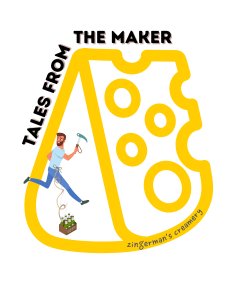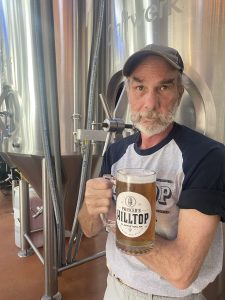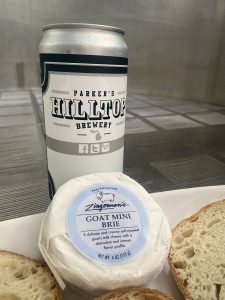

In celebration of Michigan Beer Month we’re going all out on a product and a man that represents the very essence of craft brewing in America. We’re highlighting a beer that’s so innovative that it hasn’t been recognized as a style by the Brewer’s Association. More so, this new beer is made by a living legend hailing from our home state and just happens to be the guy who taught me how to make beer 23 years ago. We’re pairing this brew with our Mini Goat Brie as unique beer demands a distinct cheese.
–
In the brewing community George Murphy needs no introduction. In fact, he’s recognized by all simply as “Murf.” Mention his name at any brewpub and a slew of tall tales will be spilled, treasured bottles uncorked, and inquiries to the tune of, “Good old Murf, what’s our lad concocted now.” Murf has been brewing and teaching our craft since 1988. He is responsible for many iconic recipes and has refined many classics. One of his stature could easily rest on his laurels and retire champion. At any given time he can pull off a familiar Scottish ale, stout, or porter from his stacked deck of recipes to please his audience. But that’s not his way. Like a renowned Japanese sword maker he is constantly sharpening his skills. What he did yesterday is not nearly good enough for today.
–
It’s a constant evolution as he modernizes his age-old techniques, always learning lessons from his pushed efforts. As a result the man is a complete master in the brewhouse having utmost control of the process. Let’s face it, making beer or cheese is complicated. Confidence comes with repetition and dedication. Murf is completely at ease with the ebbs and flow, the complexities and challenges that each day brings and thus has the capacity to take on the most intricate recipes. The lucky people of Parker’s Hilltop Brewery in Clarkston are the latest to employ Michigan’s favorite brewer. Let’s see what our fine lad has prepared for us.
–
The Cold IPA category is quite undefined these days. Most brewers are pulling off this new style by fermenting ale yeast at colder temperatures than usual. Murf has his own spin on this and is implementing a lager yeast strain that he has tamed and is fermenting at higher temperatures. The key for this brew is clean fermentation that doesn’t produce diacytyl flavor compounds found in ale production, nor sulfuric notes associated with lagers. The result is a longer fermentation with very little stress on the yeast producing something unique. Murf calls it “The Fresh Coast IPA. Fresh Coast is a tip of the hat towards our nation’s longest stretch of fresh water, The Great Lakes of Michigan.
–
The genesis of this beer starts with a simple grain bill of 70% American two-row barley and the remaining is flaked maize. The grains are mashed in a single infusion mash tun. This is where the magic takes place as the complex carbohydrates convert into tiny sugars. Size matters here, as the smaller the sugar, the easier for the yeast to digest and produce alcohol. The larger sugars simply cannot be consumed by yeasts but they still have a purpose as they add sweetness, flavor, and body to your beer.
–
Once the concoction is separated from the now devoid grains it gets transferred to the kettle and the hopping begins. Amarillo, Simcoe and Citra hops are used in abundance. Once the brew has been cooled and put to bed it’s given two more rounds of dry hopping, one during peak fermentation and one during conditioning. The fermentation is done slow and low over 4 weeks and then another two-week conditioning period. This achieves an ultra bright finished appearance even though it’s non-filtered. Murf utilizes the gravitational force of the earth instead of applying damaging equipment like centrifuges and filters to clarify his beer. “Low tech or no tech” he explains. “Large breweries simply do not have the luxury of time to curate their beer even though they know the severe pressures of equipment can speed up oxidation, sheer yeasts, and produce off-flavors. Time is important, but let the world spin a few more days and let gravity do the work for you,” he states, as he romanticizes the process. Murf has studied open fermentation so he has a great grasp of what’s happening inside the stainless steel tanks. Observation is key. Beer and cheese production are very visual. You should see and smell a problem before it becomes a problem. “It’s not rocket surgery, but it works,” he comically quips.
–
The results are a 6 percent alcohol beer that is crisp, clear, and looks like lager. It’s best poured in a tall glass to display its gorgeous pillowy white head. It has lots of bite similar to a West Coast IPA but Murf tames it at just 30 IBU’s (international bitterness units). On the tongue you get candied-orange flavors, passion fruit and other citrus notes. On the nose is pineapple, peach and tangerine. It finishes very dry just like a lager. Basically, Cold IPAs are a style unto themselves. More bitter than a hazy IPA, but crisper and cleaner than a West Coast IPA, this beer style can only be described as truly unique. What will he think up next?
–
What separates Murf from others is his willingness to teach others. “If you can’t teach it, you don’t know it.” “Our craft cannot be taught through book. It’s up to us to pass along our tribal knowledge.” Through total commitment into the task at hand and listening to the lessons learned by those who have come before Murf is ready to explore every facet while generously sharing his lesson. This guy is the Mr. Miyagi of the beer world. He humbly encourages others to seek opportunities while always being a student of his own past. Murf has done wonders for my career as a mentor, ten-fold as a friend.

–
This leads us into the teachings of my new master, but this time in the cheese world as Zingerman’s head cheesemaker. Jerry Alcenius has been passing his life-long lessons onto me. On some days I feel like I’m drinking out of the firehose trying to keep up, but cheesemaking is such an old art that information overload is quite expected. We here at Zingerman’s are so lucky to have someone who patiently brings us up to speed, a gold standard on how a world-class creamery needs to be run, all while providing top-notch comedy relief. It is my absolute privilege and pleasure to work alongside him.
–
For this unique beer Jerry and I wanted to pair it with something just as special. Everyone is familiar with Brie. But not many have dived into the goat Brie interpretation. Goat Brie’s appearance is extremely white compared to cow’s milk. This is because cows can’t convert the carotene in grasses, as a result their milk has a yellowish color and that carries over to the cheese. Goat brie has a delicate thin rind with an inner paste that when fully ripened is gooey, runny and spreadable. The aroma is milder than the cow’s variety. Goat milk has less lactose than cow’s milk…so people with a mild lactose intolerance should give goat cheese a final chance before throwing in the towel. Brie is meant to spread, so baguettes and crackers are the typical vehicle. Just make sure you let the Brie come up to temperature before devouring. Friends don’t let friends eat cold cheese.

–
Many times I overhear questions about if you can eat the rind of Brie. The answer is a resounding, “Hell, yeah!” It hosts loads of flavor and its firm texture is a must to hold the soft paste in place. In its infancy cheesemakers will inoculate the milk with Penicillium Candidum mold. This is a live culture that makes its way to the outside of the cheese and forms the natural rind. It breaks down the proteins and fats of the inner paste turning Brie’s texture from chalky and firm to soft and creamy over time.
–
Let’s tie these two products together. Murf talks about how he uses the gravitational pull to clarify and mature his beer. Cheesemakers are aware of this force as well. Cheese must be flipped daily during maturation to keep the moisture centralized. Some cheesemakers are so in tune with these natural forces that they flip their cheese twice daily during full moon cycles. If not turned the density of cheese would become structurally unsound, and your cute little wheel of Brie will flatten from the gravitational pull or worse, seep right through their racks, losing their solid form and become liquid. Not very lovely.
–
There you have it, folks…beer and cheese. The connections between the two are never ending, both being nurtured and pulled together by man, moon and earth since the dawn of time.
–
Pair thee well,
Bo Lytle
–
–
–